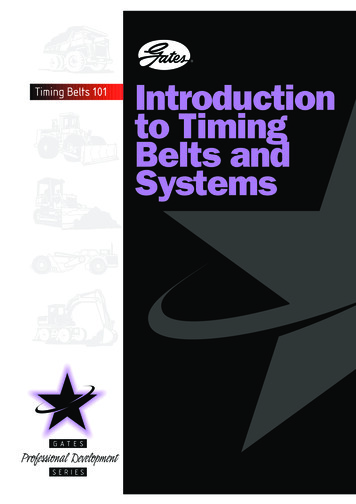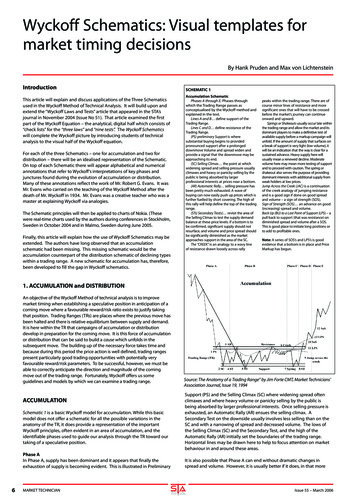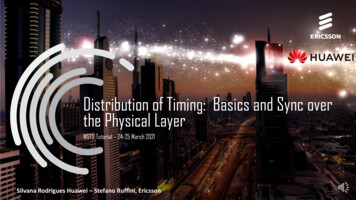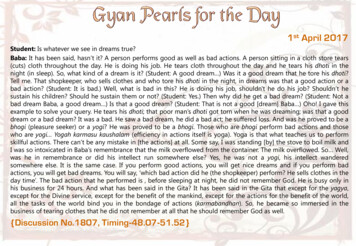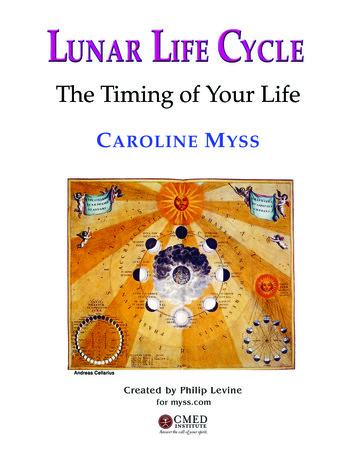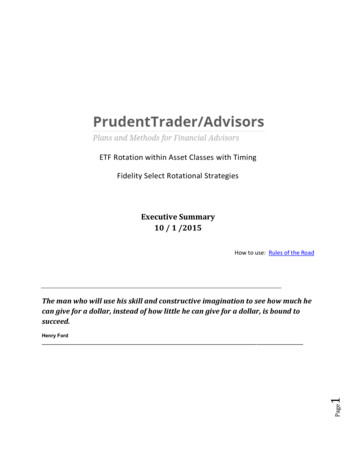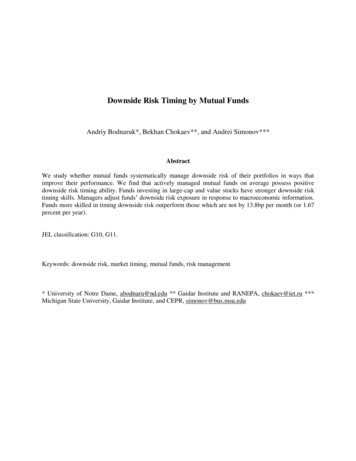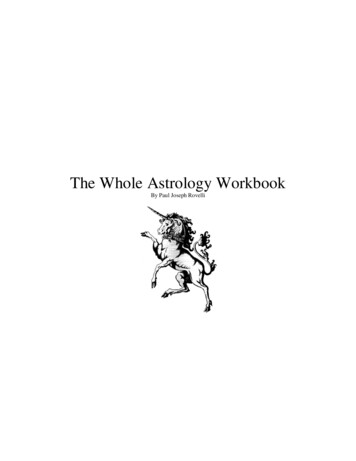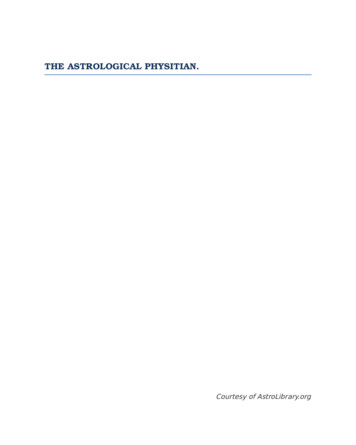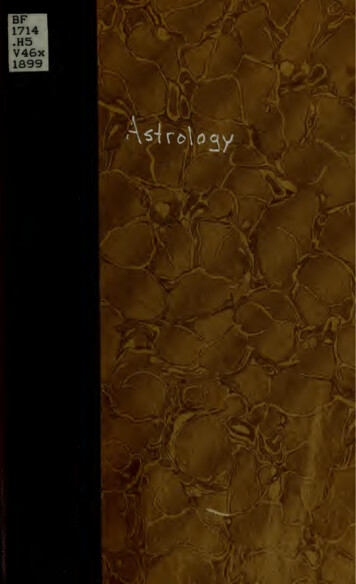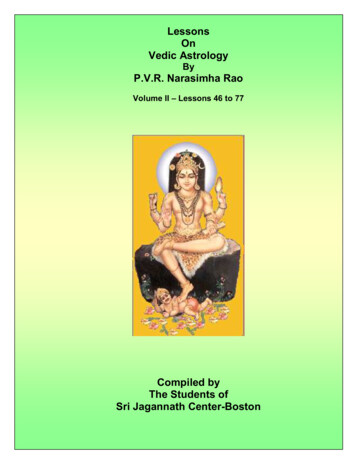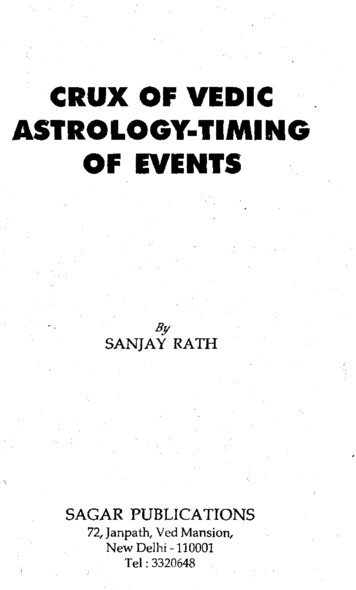
Transcription
CRUX OF VEDICASTROLOGY·TIMINGOF EVENTSBySANJAY RATHSAGAR PUBLICATIONS72, Janpath, Ved Mansion,New Delhi -110001Tel: 3320648
PREFACEVEDIC ASTROLOGYI take this opportunity to thank the erudite readerand fellow astrologers for receiving my first Qook;namely, Maharishi Jaimini's Upadesa Sutras. Whileevery effort was made to explain every stanza withumpteen examples, it was not possible to do completejustice and fully explain the ramifications of the various stanzas in a horoscope. This need to provide a holistic approach to Vedic Astrology by combining the bestpredictive tools has been fulfilled in this book.The first three chapters explain the various toolsand paradigms available in Vedic Astrology as well astheir usages. I agree that this list is quite exhaustiveand the tools felt to be of general acceptance and easyto use have been added.There are certain tools that are taught traditionallyin. families having the Jyotish tradition. I have givensome very valuable methods of timing events which, itis hoped would be of considerable use to all astrologers. For example, Jataka Parijatha gives considerableimportance to the fifth house in timing death of the native. Unless taught, it would be quite impossible forthe average astrologer to know how this is to be applied. One method would be to add the Vimsottari dasayears of the planets influencing the fifth house, expungemultiples of 30. The remainder added to date ofSankranti (Solar ingress of the month of death) wouldgive the date of demise. Another method is to take thestrongest planet influencing the fifth house and thedeath will occur in the lunar day (Tithi) ruled by it
·lThe fine timing of such events as death will be ofconsiderable use both in birth charts as well as theswearing-in charts of governments. A step by step explanation has been offered which would be of considerable use for the beginners as well as the most advancedastrologers.NARAYANA DASAAny Udu dasa system, be it the best Vimsottari orthe Astottari dasa, is essentially a method of timing thestate of the mind as it is calculated from the Moon. It ispossible that at times, the native would be having manygood things happening and yet, the mind would bedisturbed. Thus in the interaction of the native with hisenvironment, two independent factors come into play.One is the input from the environment in the form ofmessages and influences and the other is the way theindividual perceives, processes and reacts to the messages. Vimsottari dasa gives the working of the mindat a particular point of time and shows the inherent ability or otherwise to interpret and the way the nativewould receive these messages. However, a good astrologer should also have a predictive tool to determine themessages that would come from the environment Thisis the key to jyotish and is known as the Narayana dasa.Although I have explained the Narayana dasa inmy translation of Maharishi Jaimini's Vpadesa Sutras,there have been some responses that a more exhaustive explanation is necessary. This book has shown theactual use of the Narayana dasa in many instances andif after this, the request persists, I would be most gladto oblige.
IS JAIMINI DIFFERENT FROM PARASARA?Some sections of the astrological community havetried to show that Maharishi Jaimini is different fromthe traditional Parasari Jyotish and having been tryingto either hide their ignorance behind this argument orhaving been cashing in this difference by showing thattheir Jaimini system is superior or by ascribing exclusive membership to this Jaimini club! We should take acue from the most illustrious Dr. B. V. Raman who hasalways maintained that Vedic astrology requires a ho- .listic approach and has authored many books including works on Jaimini, Parasara, Prasna, Tajaka. etc.Jaimini has purposely refrained from starting anew school of Vedic Astrology and has named his classic as the Upasesa (Advisory) Sutra (Stanza). Time andagain, he has referred to the standard texts as Siddha!s.It is obvious that Maharishi Jaimini has purposelyunderplayed his classic work to avoid any misconceptions that could arise in the future, and yet these havecropped up. It is my earnest request to the astrologicalcommunity to kindly refrain from showing the minordifference of views as difference of systems and to develop a holistic approach to Vedic Astrology.MISCONCEPTIONSA number of misconceptions have been found toexist even among some of the leading lights of today.While it is a well-known fact that the fourth house refers to formal education, some astrologers have beenteaching that the fifth house deals with this! The fact isthat the fourth house deals with education. The secondand eleventh from this house have primary Argala (intervention) on it. Hence, the fifth house, being the sec-
ond from the fourth house will intervene in its affairsand rules the knowledge obtained by the native due tothis education. The eleventh from the fourth house isthe second house ruling speech and shows the speechtraining, languages and other skills acquired due to theeducation.Problems arise when the modern day astrologertries to propagate his own theories instead of trying tounderstand the wisdom of the seers. This book is anattempt to understand and apply the wisdom of theMaharishi's and it is possible that inspite of the besteffort, at places the explanation may be found to be inadequate. I shall be most grateful for the response ofthe learned readers and for their constructive criticism.ACKNOWLEDGEMENTVedic Astrology is indebted to the Sagar family forextending their unflinching support to these publications. I am most grateful to Sri Saurabh Sagar for extending all support for this publication. May SriJagannath Mahaprabhu shower his choicest blessingson him.I am grateful to my wife and children for their lovellnd emotional support May Lord Shiva crown themwith perfect knowledge. A special thanks to AshokKaushik and Dirtanath Dasa for their help and encouragement.Sanjay RathB-59, Sekhar ApartmentsMayur Vihar, Phase-INew Delhi-UO 091
CONTENTSPage No.PrefacevIntroduction1Concepts and Predictive Principles16Longevity Estimation40The Ascendant54The Second House79The Third House' 108The Fourth House127The Fifth House166The Sixth House204The Seventh House251The Eighth House319The Ninth House368.The Tenth House416The Eleventh House514The Twelfth House545
\ !l Ofq:THE CRUX OF VEDIC ASTROLOGYTIMING OF EVENTSCHAPTER I.INTRODUCTIONf :The vedic dasa system is the most potent predictive tool for an astrologer. Astrology, as is beingpractised today in India, largely relies on the Vimsottaridasa that uses a 120 year cycle incorporating fixedperiods for the nine grahas including the seven planets from the Sun to Saturn and the nodes Rahu &Ketu. The popularity of this dasa system stems fromits easy calculations, fixed unambiguous periods andthe recommendation of Para sara *1. However, KalyanVerma*2 mentions results on the basis of Moola dasaand in a similar fashion different authors have givenimportance to different systems. The firihat ParasaraHora Shastra lists a host of dasa systems includingthe Kalachakra dasa which is now gaining some popularity among Indian astrologers. Again, in the use ofthe Vimsottari dasas, what is oft n overlooked is theriders. This results in incorrect predictions and theremedial measures are quite off the mark. For example, the Tara dasa is a part and parcel ofVimsottaridasa that is often overlooked to the detriment of*1.*2.Brihat Parasana Hora ShastraSaravali
2The Crux of Vedic Astrology-Timing of EventsVedic Astrology. Thus, it is necessary to first understand the principles involved and then to pick up thedasas that are most universally applicable so thatpractising astrologers could develop a certain amountof expertise in them.2. CLASSIFICATION: The first classification is onthe basis of progression where those dasa systemsusing the Sun signs are called Rasi dasas and thoseusing the lunar mansions (constellations) are calledgraha dasas. The progression could also be on thebasis of the panchatatwas or of other divisions of thezodiac. The second classification is on the basis of themethod of reckoning. This could be from the ascendant, atmakarak, moon constellation, starting letter ofname, sun's longitude in a sign etc. The third classification is on the basis of usage into Phalita dasa(fruitful/ event prognostication) and Ayur dasa(longivity/ health).3. UDU DASA : Among the constellation basedplanetary periods, the Vimsottari dasa (120 year)and Astottari dasa (108 year) stand out as beingof universal application. The sum of the periodsof the luminaries equals the period of the tutor(Guru) of the dasa system. Thus Jupiter is the Guruof Vimsottari dasa (Sun 6 Moon 10 Jupiter 16)while Venus is the Guru of the Astotlari dasa (Sun6 Moon 15 Venus 21). The other constellation baseddasas suffer from a number of limitations and sincethey lack universality of application, they may beoverlooked by the practising astrologers. [Details ofthe dasas can be had from Brihat Parasara HoraShastra or any other standard text]. However, inactual practise it will be seen that the Vimsoltari dasawith Jupiter as the Guru is the best constellation
Introduction3based Phalita dasa while the Astottari dasa with Venus (Sanjeevani-mantra) as the Guru is the best constpllation based Ayur dasa. Secondly, the ududasas arevery helpful in pinpointing the event while its occurrence will require confirmation from a Rasi dasa.4. Narayana dasas : (alias Padakrama dasa)comprising three types of Rasi dasas for movable,fixed and dual signs in the ascendant is the bestPhalita dasa. The dasas for movable signs are alsocalled Chara dasas. (Readers may refer to my book :The Vpadesa Sutras of Jaimini for details about thisand others Rasi dasas). The Lagnadi Rasi dasa (alsocalled Sudasas) are generally used for timing finance,fortune, marriage etc. and are to be used in preferenceto the Narayan dasa, only when the moon sign isstronger.5. The Ayur dasas can be classified on the basis ofreckoning the dasa either on the basis of gestation/pregnancy period (where one antardasa is equal tothe period of gestation) or on the basis of maximumlongeVity. The Navamsha and Shoola dasas are framedon the basis of one antardasa being equal to theperiod of gestation of a particular animal. For example, for Human charts, the gestation period (pregnancy) is for about 9 solar months which becomes theantardasa. Twelve such antardasas give the dasa of asign at 9 years and twelve such signs give the maximum longeVity at 108 years. In this manner the Shooladasas for all animals can be determined.The problemthat naturally arises is the estimation of the period ofpregnancy or "gestation" of inanimate objects andHorary Charts. For this purpose, the maximumlongeVity is first considered and then the periodsdistributed amongst the signs. Now, the maximum
4The Crux of Vedic Astrology-Timing 01 Eventslongevity of the Human being has been given bymost standard texts as 12fJ years. If this period isequally distributed among the 12 signs, the dasa ofeach sign will be 10 years and will be more than theNavamsa/ Shoola dasa of 9 years or the Sthira dasa·average of 8 years. This is the Sandhya dasa of 10 yearperiods and is used when the short, middle and longlife is estimated in the ranges of 40, 80 and 120 yearsrespectively (Readers may refer to : The UpadesaSutras of Jaimini for longevity estimation).The maximum longevity system finds its use inmundane matters like say, the swearing in ceremonyof the Prime Minister or such matters. For example,the maximum longevity of the Lok Sabha is 5 yearsindicating that the Shoola dasas will have a period of5 months for each sign (being one-twelfth of themaximum longevity). Thus, the Ayur dasas require anintelligent application of mind. If, on the other hand,the udu dasas like Astotari are to be used, these can bescaled down proportionately.6. A correct assessment of the initiating point forthe Vimsottari dasa holds the key to timing events.Jataka Parijatha XVIII. 33-35.fCl{:;P1dl{r 'i1IJOtdl ISI r 1a1'Pllfl I \G IIS4)ila\ : II , IThe strongest among the following: (a) Lagna star(b) Moon Star (c) 'Name initial' star and (d) Moon star atquery, will furnish the starting Vimsottari dasa. Starting with the dasa of the lord of the strongest star andin the order of the (Vimsottari) constellation dasa,the erudite astrologers predict the destiny of thenativity.
Introduction5nativity.\3,q"'11 71 C1J1 ffiG!1llq I ISC\ 'qen LlI,Sh d'j q G!1I1If1C1IPi Im ISOjI"' lq:;('f 11(10IlSOj, I I I IIf the sign containing the utpanna constellation(next stanza) be stronger than the other four in thepreceding stanza, it is possible that the events of thelife will unf ld on the basis of this utpanna constellation as the starting point The ending of all dasas willbe difficult. I SOjI .SOjt?I(Cl\1 rnT3ffirt G!1l1q 11 JOj Jt,gSlGI BW10lif4,,"qI1,,"q SOjlglS{i fttUlqo-:q !1(Gll1IPdA I I I IThe fourth, fifth and eighth constellations fromthat occupied by the Moon be ascertained. TheVimsottari dasas are calculated from each of thesestars (i.e. the lord of the stars furnishes the first dasa).The dasa from the fourth star is called Kshema, fromthe fifth star is called utpanna and from the eighth staris called Adhana. If the dasas (at any point of time)have a common ending date for any dasa, then thiscan show death. For short, middle and long life, thethird, fifth and seventh dasas respectively will furnishthe death inflicting d.asa.Thus, excluding the star occupied by the Moon atquery, we have four possible constellations that caninitiate the Vimsottari dasa. These are (a) the natalmoon constellation (b) the natal ascendant constellahon (c) the name letter constellation or (d) the utpanna(5th from natal moon) constellation. Whichever ofthese associates with Jupiter or Mercury or the signoccupied by the c
Now, this range of 23 20'to 26 40' will include Jwo Saptamsas, the first from 23 20' to 25 43' and the . other from 25 43'to 26 40' (i.e. Cancer or Leo Saptamsa lagna). With Cancer in the Saptamsa (D-7) in lagna, the fifth lord (reverse count) is Jupiter indicating a male child in conjunction with Rahu.
